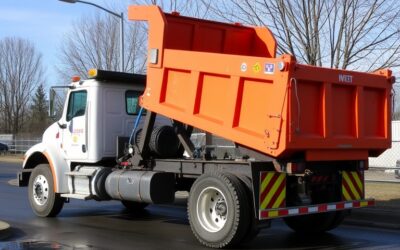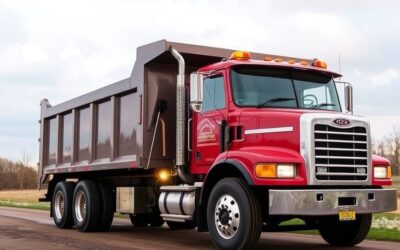Dump trucks are crucial in construction and industrial work, but handling heavy loads brings serious safety risks—especially tipping. To address these hazards, technological advancements have led to the creation of automatic lowering systems, which play a crucial role in enhancing the safety and stability of dump trucks.
Automatic lowering systems lower the truck bed as soon as a tipping risk is detected, keeping your truck stable and safe. This technology reduces the truck’s center of gravity, helping to stabilize the vehicle and prevent accidents. Understanding how these systems work and their benefits can help operators use them effectively and maintain a safer working environment.
The implementation of these systems involves sophisticated sensors and control units that constantly monitor the truck’s balance and load distribution. When the system detects a potential tip-over, it activates the lowering mechanism, which promptly lowers the truck bed. This proactive measure can make a significant difference in preventing accidents and ensuring the welfare of drivers and workers.
In this article, we delve into the science behind automatic lowering systems in dump trucks, how they enhance safety, the key components involved, and best practices for their operation. Understanding these aspects will provide valuable insights into why these systems are essential for modern dump truck operations.
Understanding Automatic Lowering Systems in Dump Trucks
Automatic lowering systems are cutting-edge technologies designed to boost dump truck safety and stability. These systems are crucial for preventing tipping incidents by lowering the truck bed automatically when a risk is detected. This proactive feature helps reduce the center of gravity, making the truck more stable.
The system works through a series of sensors and control units. Sensors monitor the truck’s angle and balance continuously. When sensors detect a tilt beyond safe limits, they signal the control unit to take action. The control unit then activates the lowering mechanism, rapidly lowering the truck bed to stabilize the vehicle. This process happens in real-time, offering immediate corrective action to prevent accidents.
What makes automatic lowering systems particularly effective is their ability to operate without driver intervention. Drivers are often occupied with managing the load and navigating rough terrain, making it challenging to notice potential tipping hazards in time. With automatic lowering systems, the technology does the monitoring and reacting, allowing drivers to focus on other critical operational tasks.
Understanding how these systems function highlights their importance in modern dump truck operations. They provide an extra layer of safety, mitigating the risks associated with heavy loads and uneven ground.
How Automatic Lowering Systems Enhance Safety
Automatic lowering systems are essential for improving dump truck safety, tackling the main risk of tipping. Here’s how they contribute to a safer working environment:
- Real-Time Monitoring and Response: One of the primary safety benefits of automatic lowering systems is their ability to monitor the truck’s stability continuously. The sensors detect any dangerous tilting angles and prompt an immediate response. This real-time response prevents accidents when the driver may not notice tipping fast enough.
- Reducing Human Error: Human error is a common factor in tipping incidents. Drivers might misjudge the angle of the terrain or the distribution of the load. Automatic lowering systems mitigate these risks by taking proactive measures without requiring human intervention. They ensure that regardless of the driver’s actions or mistakes, the truck remains stable and safe.
- Enhanced Load Stability: By automatically lowering the truck bed when a tilt is detected, these systems reduce the center of gravity of the load. This increased stability is especially important during dumping operations. When the bed is raised to offload materials, the truck becomes more susceptible to tipping. Automatic lowering systems quickly lower the bed if instability is detected, preventing a potential tip-over.
- Increased Driver Confidence: Knowing that an automatic system is in place to prevent tipping can help drivers feel more confident and focus better on their tasks. This confidence translates to better overall operation and fewer stress-related mistakes, further enhancing safety on the job site.
Incorporating automatic lowering systems into dump trucks is a significant step towards safer and more reliable operations. These systems provide a robust solution to tipping hazards, making them indispensable in heavy-duty truck operations.
Key Components of Automatic Lowering Systems
Understanding the key components of automatic lowering systems is essential for appreciating their functionality and reliability. These systems include several vital elements that work together to ensure the dump truck remains stable and safe during operations.
- Tilt Sensors: Tilt sensors are the backbone of automatic lowering systems, constantly measuring the truck bed’s angle. If the tilt exceeds a predetermined threshold, the sensors send a signal to the control unit, prompting it to act.
- Control Unit: The control unit is the system’s brain, processing signals from the sensors to decide when action is needed. If the sensors indicate a potential tipping hazard, the control unit activates the lowering mechanism.
- Hydraulic Actuators: Hydraulic actuators are responsible for lowering the truck bed. When the control unit sends a signal, these actuators engage to quickly and smoothly lower the bed, reducing the center of gravity and stabilizing the truck.
- Alert Systems: In addition to automatic lowering, many systems include alert mechanisms such as visual or auditory alarms. These alerts warn the driver about the truck’s stability status, allowing for additional manual interventions if necessary.
Each of these components is crucial for the overall effectiveness of the system. By understanding their roles, operators can better appreciate how automatic lowering systems maintain stability and prevent accidents.
Best Practices for Operating Dump Trucks with Automatic Lowering Systems
While automatic lowering systems significantly enhance safety, following best practices during operation is essential for maximizing their benefits. Here are some practical tips for operating dump trucks equipped with these systems:
- Regular Maintenance: Keep all components of the automatic lowering system in good working condition through regular maintenance. Inspect sensors, control units, and hydraulic actuators periodically to ensure they function correctly.
- Proper Loading: Even with advanced systems, good loading practices are essential. Make sure the load is evenly distributed to minimize the risk of tipping. Avoid overloading the truck beyond its capacity.
- Training and Awareness: Make sure drivers know how the system works and how to react to alerts. Awareness of the system’s functions helps drivers feel more confident and secure in their operations.
- Monitor Alerts: Always pay attention to any visual or auditory alerts the system provides. These warnings are designed to give drivers enough time to take corrective actions if needed.
- Safe Driving Practices: Adopt safe driving practices such as avoiding sudden turns, hard braking, or quick accelerations. Steady and careful driving helps maintain load stability and minimizes the chances of tipping.
By adhering to these best practices, operators can significantly reduce the risk of accidents and ensure a safer work environment.
Conclusion
Automatic lowering systems are essential tech advancements, offering enhanced safety and stability for dump trucks. These systems, with their tilt sensors, control units, hydraulic actuators, and alert mechanisms, work together to prevent tipping incidents by proactively lowering the truck bed when instability is detected. Understanding these components and incorporating best operational practices can ensure their effectiveness.
For businesses involved in heavy-duty transportation and construction, the implementation of automatic lowering systems is non-negotiable for maintaining a safe workplace. Regular maintenance, proper loading techniques, training, and safe driving practices are all crucial aspects that, when combined with advanced technology, create a robust safety net for dump truck operations.
Want to safeguard your dump trucks from tipping hazards? Explore our Wink Anti Tip kits to learn how we can help you implement cutting-edge safety solutions in your fleet. Visit our website at winkantitip.com for more information.





